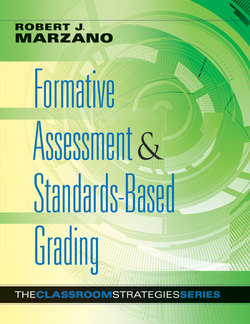Читать книгу Formative Assessment & Standards-Based Grading - Robert J Marzano - Страница 6
ОглавлениеCONTENTS
| Italicized entries indicate reproducible pages. | |
| ABOUT THE AUTHOR | |
| INTRODUCTION | |
| How to Use This Book | |
| CHAPTER 1 | RESEARCH AND THEORY |
| Feedback | |
| Assessment | |
| Grading | |
| Translating Research Into Classroom Practice | |
| CHAPTER 2 | THE ANATOMY OF FORMATIVE ASSESSMENT |
| Types of Classroom Assessments | |
| Uses of Classroom Assessments | |
| The Importance of Changing Behavior | |
| Summary | |
| Exercise 2.1: Obtrusive, Unobtrusive, and Student-Generated Assessments | |
| Exercise 2.2: Instructional Feedback Versus Formative Scores | |
| Exercise 2.3: Review Questions | |
| CHAPTER 3 | THE NEED FOR A NEW SCALE |
| The 100-Point Scale | |
| A Rigorous Rubric-Based Approach | |
| Using Preexisting Assessments | |
| Summary | |
| Exercise 3.1: Simpler and More Complex Content for Learning Goals | |
| Exercise 3.2: Scoring Assessments Using the Scale | |
| Exercise 3.3: Review Questions | |
| CHAPTER 4 | DESIGNING ASSESSMENTS |
| Selected-Response Items in Obtrusive Assessments | |
| Short Constructed-Response Items in Obtrusive Assessments | |
| Designing and Scoring Assessments Using Selected-Response and Short Constructed-Response Items | |
| Extended Constructed-Response Items in Obtrusive Assessments | |
| Oral Responses in Obtrusive Assessments | |
| Demonstrations in Obtrusive Assessments | |
| Unobtrusive Assessments | |
| Student-Generated Assessments | |
| Summary | |
| Exercise 4.1: Designing Selected-Response Assessment Items | |
| Exercise 4.2: Designing Extended Constructed-Response Tasks and Demonstration Tasks | |
| Exercise 4.3: Review Questions | |
| CHAPTER 5 | TRACKING STUDENT PROGRESS |
| Approach 1: Summative Score Assigned at the End of the Grading Period | |
| Approach 2: Gradual Accumulation of a Summative Score | |
| Approach 3: The Whole Class Progresses as One | |
| Approach 4: Continual Improvement Throughout the Year | |
| Celebrating Current Status and Knowledge Gain | |
| The Role of Technology | |
| Summary | |
| Exercise 5.1: Record Keeping in the Four Approaches | |
| Exercise 5.2: Review Questions | |
| Gradesheet for Approach 1 | |
| Gradesheet for Approach 2 | |
| Continual Progress Report | |
| CHAPTER 6 | GRADING AND REPORTING |
| The Overall Grade | |
| Changing School and District Report Cards | |
| Summary | |
| Exercise 6.1: Converting Scores | |
| Exercise 6.2: Standards-Referenced Reporting | |
| Exercise 6.3: Standards-Based Reporting | |
| EPILOGUE | |
| APPENDIX A: ANSWERS TO EXERCISES | |
| Answers to Exercise 2.1: Obtrusive, Unobtrusive, and Student-Generated Assessments | |
| Answers to Exercise 2.2: Instructional Feedback Versus Formative Scores | |
| Answers to Exercise 2.3: Review Questions | |
| Answers to Exercise 3.1: Simpler and More Complex Content for Learning Goals | |
| Answers to Exercise 3.2: Scoring Assessments Using the Scale | |
| Answers to Exercise 3.3: Review Questions | |
| Answers to Exercise 4.1: Designing Selected-Response Assessment Tasks | |
| Answers to Exercise 4.2: Designing Extended Constructed-Response Tasks and Demonstration Tasks | |
| Answers to Exercise 4.3: Review Questions | |
| Answers to Exercise 5.1: Record Keeping in the Four Approaches | |
| Answers to Exercise 5.2: Review Questions | |
| Answers to Exercise 6.1: Converting Scores | |
| Answers to Exercise 6.2: Standards-Referenced Reporting | |
| Answers to Exercise 6.3: Standards-Based Reporting | |
| APPENDIX B: WHAT IS AN EFFECT SIZE? | |
| REFERENCES | |
| INDEX |
